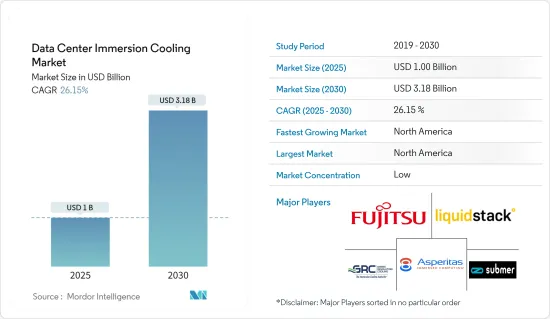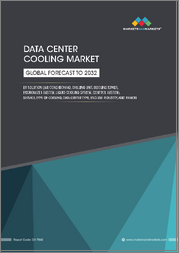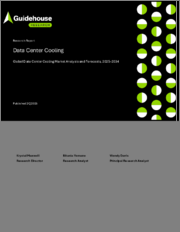
|
시장보고서
상품코드
1687811
데이터센터 액침냉각 시장 : 시장 점유율 분석, 산업 동향 및 통계, 성장 예측(2025-2030년)Data Center Immersion Cooling - Market Share Analysis, Industry Trends & Statistics, Growth Forecasts (2025 - 2030) |
||||||
데이터센터 액침냉각 시장 규모는 2025년에 10억 달러로 추정되고, 예측 기간인 2025-2030년 CAGR 26.15%로 성장할 전망이며, 2030년에는 31억 8,000만 달러에 달할 것으로 예측됩니다.

이 기술에 대한 수요가 증가함에 따라 Supermicro나 후지쯔 등의 기업은 액침냉각에 대응한 여러 서버 라인을 제공합니다. 몇몇 하드웨어 제조사는 액침냉각 기반 설치에서는 팬이 필요 없음을 서버에 알리는 펌웨어나 BIOS 업데이트를 시작했으며, 이는 주로 업계가 하드웨어 냉각 기술로 이행할 준비가 되어 있음을 보여줍니다.
주요 하이라이트
- 데이터센터의 이산화탄소 배출량 증가도 액침냉각과 같은 고도의 액냉 기술 채용 확대로 이어지는 큰 문제입니다. 액침냉각 시장에서 저명한 합성냉각제 공급자인 3M사가 최근 실시한 조사에서는 기존의 공기 기반 냉각 기술을 갖춘 데이터센터에서 필요로 하는 전력의 38%가 전자부품 냉각에 이용되고 있는 것으로 나타났습니다.
- 인도나 중국 등의 신흥 경제 국가에서의 IT 구조의 개발은 데이터센터 수요를 호전시킬 것으로 예상됩니다. IT 업계에 있어서 비용면에서도 운용면에서도 메리트가 있는 클라우드 모델의 채용이 증가하고 있기 때문에 데이터센터의 수요는 증가할 것으로 예상됩니다.
- NTT Ltd의 조사에 의하면, 응답자의 절반 이상이 클라우드 모델이 조직의 사업 운영에 가장 큰 변화를 가져올 것이라고 말하고 있습니다. 따라서 데이터 센터 냉각에 대한 수요는 증가할 것으로 예상되며 최종 사용자의 기호에 기반한 액냉 방식의 실행으로 이어집니다.
- Uptime이 최근 실시한 연차 조사에서는 20kW 이상의 랙 도입이 감소하고 있는 것으로 나타났습니다. 전년 대비로는 대부분의 응답자가 10-19kW 범위에서 가장 고밀도의 랙을 사용하고 있음을 강조하고 있습니다. 직접 액냉은 랙 밀도가 20-25kW보다 높아지면 보다 경제적이고 효과적입니다.
- 대기업에 있어서는 고장난 서버를 통상보다 빈번하게 교환하는 것이, 하이퍼스케일 시설을 저온에서 운용하는 것보다, 장기적으로는 비용이 들지 않을 가능성이 있습니다. 그래도 더 나은 컴퓨팅 파워의 필요성으로 데이터 센터에서 GPU의 통합이 진행되고 있기 때문에 대기업은 효과적인 냉각 기술로 이행해야 합니다.
- COVID-19의 발생은 다양한 분야에 걸친 여러 경제에 추가 스트레스를 가져왔습니다. 이에 따라 초점은 디지털 경제로 전환되었습니다. 중국의 최고 클라우드 컴퓨팅 공급업체인 알리바바 클라우드는 '포스트 팬데믹 월드'의 디지털 전환 수요를 지원하기 위해 차세대 데이터센터 건립에 수십억 달러를 투자하고 있습니다.
- 데이터센터의 에너지 사용량은 COVID-19 팬데믹이 가져온 텔레워크 및 기타 가상 활동 증가에 의해 더욱 증가하고 있습니다. 따라서 지속 가능한 냉각 기술을 이용한 개발이 증가하고 있습니다
데이터센터 액침냉각 시장 동향
에지 컴퓨팅이 크게 성장
- 예측 기간 중 기업은 대량의 IP 트래픽을 처리하는 IP 접속 모바일 기기나 M2M(Machine-to-Machine) 기기의 급속한 보급을 목격할 것으로 예상됩니다. 온라인 프로바이더로부터의 Wi-Fi 서비스나 애플리케이션 전달의 고속화에 대한 수요가 높아질 것으로 예상됩니다. 자율주행차 등 일부 M2M 기기에서는 안전성을 확보하기 위해 로컬 처리 리소스와의 실시간 통신이 필요합니다.
- 에지 데이터센터의 배치는 5세대(5G) 네트워크, IoT 및 IIoT 디바이스, 가상현실 및 증강지능, 인공지능 및 머신러닝, 데이터 분석, 자율 주행 차량, 비디오 스트리밍 및 모니터링 등 많은 신기술에 혜택을 제공합니다.
- 5G 라디오 인프라의 출현으로 데이터센터 운영자는 보다 낮은 지연 시간과 높은 내결함성을 제공하는 네트워크와 협력하는 에지 컴퓨팅 인프라를 선택하도록 촉구받고 있습니다. 멀티액세스 에지 컴퓨팅(MEC)은 네트워크 서비스가 사용자와 밀접하게 연결될 수 있도록 지원합니다.
- 따라서 효율적인 엣지 데이터센터 수요는 세계 5G 기술 도입, 자율주행차, 자율주행차, 스마트시티 증가 추세 등 많은 요인에 따라 증가할 것으로 예상됩니다. 인텔에 따르면 2024년으로 예측되는 전 세계 자율주행차 등록 점유율은 0.49%이며 2030년에는 12%에 이를 것으로 예상됩니다.
- 그러나 대규모 에지 컴퓨팅 전개에서 중요한 요구 사항은 운영 비용이 낮은 것입니다. 에지의 전개에 있어서, 액침냉각은 극적인 에너지 절약 효과를 가져옵니다. 액냉 솔루션의 신뢰성과 노터치 기능은 원격지에 설치된 기기의 실행 가능한 운영과 관리를 위해 유지보수까지의 평균 시간을 연장하고 개입 간격을 늘려야 할 필요성에 적합합니다.
- 많은 기업들에게 디지털 전환의 일환인 인공지능(AI)은 데이터센터의 관리, 생산성, 인프라에 큰 영향을 미칠 것으로 예상됩니다. 세계의 데이터센터 건설업계도 활황세를 보이고 있으며 클라우드 도입 확대가 빅데이터와 IoT 투자의 새로운 기회를 촉진해 초대규모 데이터센터 증가로 이어지고 있습니다.
- AI와 빅데이터 분석에는 높은 냉각 능력이 필요하며, 많은 액침 벤더와 냉각 벤더가 OEM과 제휴하여 서비스를 향상시키기 위해 노력하고 있습니다. 기업은 경쟁 우위성을 획득하기 위해 전략적이고 창조적으로 IT 인프라를 활용해야 합니다. 액침냉각은 AI 애플리케이션과 같은 고밀도 워크로드의 성능을 유지하면서 전력 소비를 효과적으로 줄입니다.
북미가 큰 시장 점유율을 차지
- 데이터센터 투자자는 직접 칩 냉각과 액침 솔루션에 투자하고 있습니다. 세계에서 5G 네트워크가 출현해, 에지 데이터센터의 중요성이 높아지고 있지만, 미국은 이 기술을 재빨리 채용한 나라의 하나입니다. 미국에서는, Edge Presence, Edge Micro, American Towers 등 많은 사업자가 에지 데이터 센터에 대한 투자를 개시하고 있습니다.
- Cisco Systems의 보고서에 따르면 미국의 모바일 데이터 트래픽은 해마다 크게 증가하고 있으며 2017년에는 월간 1.26 엑사 바이트의 데이터 트래픽이었지만 2022년에는 월간 7.75 엑사 바이트의 데이터 트래픽이 되었습니다. 에릭슨에 따르면, 이 데이터 트래픽은 2030년까지 3배 더 될 것으로 예상되고 있습니다. 따라서 이러한 규모로 쉽게 연결하기 위해 필요한 저지연과 광대역 폭을 확보할 수 있는 가능성이 있는 분산형 클라우드가 실용화되고 있습니다.
- 미국에서는 인터넷 이용이 대폭 증가하고 있습니다. 이 나라는 최대의 데이터센터 운용 시장이며, 최종 사용자에 의한 데이터 소비 증가에 의해 확대를 계속하고 있습니다. 사물인터넷(IoT)의 보급이 미국의 초대규모 데이터센터 시장을 견인하고 있으며, 비즈니스 사용자나 소비자가 생성하는 엑사바이트급 데이터를 지원할 수 있는 시설의 증설로 이어지고 있습니다.
- Switch는 Dell 및 FedEx와 제휴하여 미국에 에지 데이터센터 시설을 배치하여 공동 위치 서비스 제공업체인 DataBank는 미국의 에지 데이터센터 공급자인 EdgePresence에 3,000만 달러를 투자하여 고객의 워크로드를 에지 센터에 연결하여 서비스 지연을 줄였습니다.
- 세계의 입지 자문 프로바이더인 Site Selection Group(경제적 인센티브, 기업 부동산 서비스, 공냉 시스템)에 의하면, 이 지역에서의 경제적 냉각 능력은 최대에 이르렀습니다. 보다 많은 데이터센터가 랙을 용량 가득 채우는 것을 목표로 하고 있기 때문에, 액냉은 보다 현실적인 솔루션이 되고 있습니다.
데이터센터 액침냉각 시장 개요
시장 경쟁은 치열하고 예측 기간 동안 더욱 격화될 것으로 예상됩니다. Fujitsu Limited, Green Revolution Cooling Inc., Submer Technologies SL, Liquid Stack Inc., and Asperitas Company 등의 주요 기업은, 제품 포트폴리오를 강화해, 지속 가능한 경쟁 우위성을 확보하기 위해서, 제휴, 공동 연구 및 매수 등의 전략을 채용하고 있습니다.
- 2023년 11월-리퀴드 스택은 가장 시판되는 DTC(Direct-to-Chip) 솔루션에 대응하도록 구성할 수 있는 유니버설 냉각액 분배 유닛(CDU)의 새로운 시리즈를 발표했습니다. AI, HPC, 고도의 클라우드 컴퓨팅 용도에 적합한 리퀴드 스택의 범용 CDU 시리즈는 800kW-1.5MW의 배열을 실현해, DTC용으로 특별히 설계되었습니다.
- 2023년 10월-인텔과 서브머는 단상 침지 기술의 강력한 기반 확립에서 협력하여 강제 대류형 히트 싱크(FCHS) 패키지라는 형태로 획기적인 진보를 이루었습니다. 데이터센터 냉각에 혁명을 가져오는 FCHS는 열설계전력(TDP)이 1000W를 넘는 칩의 포괄적인 열 포착과 방열에 필요한 부품의 양과 비용을 절감합니다.
기타 혜택 :
- 엑셀 형식 시장 예측(ME) 시트
- 3개월의 애널리스트 서포트
목차
제1장 서론
- 조사의 전제조건 및 시장 정의
- 조사 범위
제2장 조사 방법
제3장 주요 요약
제4장 시장 인사이트
- 시장 개요
- 업계의 매력도-Porter's Five Forces 분석
- 공급기업의 협상력
- 구매자의 협상력
- 신규 참가업체의 위협
- 경쟁도
- 대체품의 위협
- COVID-19의 업계에 대한 영향 평가
- 업계 공급망 분석
- 불소계 액체 공급자 및 제조업체
- 액침냉각욕 장치 벤더
- 데이터센터 및 벤더
제5장 시장 역학
- 시장 성장 촉진요인
- 하이퍼스케일 데이터센터 증가
- 고밀도 소비 전력에 대응
- 시장 성장 억제요인
- 다액의 설비투자
제6장 기술 스냅샷
- 데이터센터 냉각의 진화
- 에너지 소비 및 컴퓨팅 밀도 지표와 주요 고려 사항
- 유체, 프로세서, GPU, 랙, 인프라 프로바이더의 내역
제7장 시장 세분화
- 유형별
- 단상 액침냉각 시스템
- 2상 침지냉각 시스템
- 냉각액별
- 광물유
- 탈이온수
- 플루오로카본계 유체
- 합성유체
- 용도별
- 고성능 컴퓨팅
- 엣지 컴퓨팅
- 인공지능
- 암호화 통화 마이닝
- 기타 용도
- 지역별
- 북미
- 유럽
- 아시아
- 호주 및 뉴질랜드
- 라틴아메리카
- 중동 및 아프리카
제8장 경쟁 구도
- 기업 프로파일
- Fujitsu Limited
- Green Revolution Cooling Inc.
- Submer Technologies SL
- Liquid Stack Inc.
- Asperitas Company
- LiquidCool Solutions
- Midas Green Technologies
- Iceotope Technologies Ltd
- Wiwynn Corporation
- DCX Ltd
제9장 투자 분석
제10장 시장의 미래
AJY 25.05.07The Data Center Immersion Cooling Market size is estimated at USD 1.00 billion in 2025, and is expected to reach USD 3.18 billion by 2030, at a CAGR of 26.15% during the forecast period (2025-2030).

Owing to the increasing demand for this technology, companies such as Supermicro and Fujitsu offer several server lines ready for immersion cooling. Several hardware manufacturers are launching firmware and BIOS updates to inform servers that fans are not required in immersion-cooling-based installations, primarily indicating the industry's readiness to shift to hardware cooling technologies.
Key Highlights
- The increasing carbon footprint of the data centers is another major issue leading to the increased adoption of advanced liquid cooling technology, such as immersion cooling. In a recent study conducted by company 3M, a prominent synthetic coolant provider in the immersion cooling market, it was identified that 38% of the electricity needed in data centers equipped with traditional air-based cooling technologies is utilized to cool the electronic components.
- The developments in the IT structure in emerging economies, such as India and China, are expected to boost the demand for data centers favorably. The demand for data centers is anticipated to increase due to the increasing adoption of the cloud model, which has cost and operational benefits for the IT industry.
- According to an NTT Ltd study, over half of the respondents stated that the cloud model would have the most transformational impact on their organization's business operations. Therefore, the demand for the cooling of data centers is anticipated to increase, leading to the execution of liquid cooling methods based on end-user preferences.
- Uptime launched its recent annual survey, which found that racks consisting of 20 kW and advanced are decreasingly deployed. On a time-over-year base, most respondents highlighted their highest density rack usage in the 10-19 kW range. Direct liquid cooling becomes more economical and effective when rack densities higher than 20- 25 kW are preferred.
- For large enterprises, replacing failed servers more constantly than usual may be less expensive over time than operating a hyperscale facility at lower temperatures. Still, with the growing integration of GPUs in data centers urged by the need for better computing power, large enterprises must move toward an effective cooling technology.
- The outbreak of COVID-19 posed further stress on multiple economies across various sectors. This shifted the focus toward a digital economy. China's top cloud computing provider, Alibaba Cloud, invests billions in building next-generation data centers to support digital transformation needs in a"post-pandemic world."
- Data center energy usage has been compounded due to increased teleworking and other virtual activities brought on by the COVID-19 pandemic. Thus, developments using sustainable cooling technologies are on the rise.
Data Center Immersion Cooling Market Trends
Edge Computing to Witness Major Growth
- In the forecast period, organizations are expected to witness rapid growth in IP-connected mobile and machine-to-machine (M2M) devices, which handle significant amounts of IP traffic. The demand for faster Wi-Fi service and application delivery from online providers is expected to rise. Some M2M devices, such as autonomous vehicles, require real-time communications with local processing resources to ensure safety.
- The deployment of edge data centers benefits many new technologies, including fifth-generation (5G) networks, IoT and IIoT devices, virtual and augmented reality, artificial intelligence and machine learning, data analytics, autonomous vehicles, and video streaming and surveillance.
- The emergence of 5G wireless infrastructure has urged data center operators to opt for edge computing infrastructure to work with networks offering lower latency and higher resiliency. Multi-access edge computing (MEC) aids network services in connecting to users closely.
- Hence, the demand for efficient edge data centers is expected to be augmented by many factors, including the introduction of 5G technology worldwide and the growing trend of autonomous or self-driving vehicles and smart cities. According to Intel, the projected global autonomous vehicle registration share in 2024 is 0.49%; by 2030, the registration share is expected to reach 12%.
- However, a key requirement of large-scale edge computing roll-outs will be low operating costs. In edge deployments, immersive liquid cooling provides dramatic energy-saving benefits. The reliability and no-touch features of liquid cooling solutions will match the need for extended mean time to maintenance and longer intervention intervals for viable operation and management of remotely located equipment.
- Artificial intelligence (AI), a part of the digital transformation for many enterprises, is anticipated to impact data center management, productivity, and infrastructure significantly. The global data center construction industry is also booming, as increasing cloud adoption fuels new opportunities in big data and IoT investment, leading to more hyper-scale data centers.
- AI and big data analytics require a high cooling power, encouraging many liquid immersion and cooling vendors to partner with OEMs to improve their offerings. Enterprises must leverage their IT infrastructure strategically and creatively to gain a competitive advantage. Immersion cooling effectively reduces power consumption while maintaining performance across high-density workloads like AI applications.
North America to Hold Significant Market Share
- The data center investors are investing in direct-to-chip cooling and liquid immersion solutions. The emergence of 5G networks worldwide facilitates the importance of edge data centers, and the United States is among the earliest adopters of the technology. Many operators in the United States, such as EdgePresence, EdgeMicro, and American Towers, have started investing in these centers.
- The mobile data traffic in the United States increased considerably over the years, from 1.26 exabytes per month of data traffic in 2017 to 7.75 exabytes per month of data traffic by 2022, as reported by Cisco Systems. According to Ericsson, this data traffic is expected to triple further by 2030. Thus, the distributed cloud that may secure the low latency and high bandwidth required to easily connect at such a scale is coming into action.
- The United States is witnessing a substantial increase in internet usage. The country is the largest data center operations market, and it continues to expand due to the higher data consumption by end users. The popularity of the Internet of Things (IoT) is driving the US hyper-scale data center market, leading to additional facilities that can support exabytes of data generated by business users and consumers.
- Switch partnered with Dell and FedEx to deploy edge data center facilities in the United States. DataBank, a colocation service provider, invested USD 30 million in EdgePresence, an edge data center provider in the United States, to collocate their customer workloads to edge centers to reduce latency in their services.
- According to the Site Selection Group, a global location advisory provider, economic incentive, corporate real estate services, and air-cooled systems, it reached its maximum economic cooling capability in the region. As more data centers aim to pack racks to capacity, liquid cooling becomes a more viable solution.
Data Center Immersion Cooling Market Overview
The market studied reflects high competitiveness and is expected to intensify further during the forecast period. Key players, including Fujitsu Limited, Green Revolution Cooling Inc., Submer Technologies SL, Liquid Stack Inc., and Asperitas Company, employ strategies like partnerships, collaborations, and acquisitions to fortify their product portfolios and secure sustainable competitive advantages.
- November 2023 - Liquid Stack announced its new range of universal coolant distribution units (CDUs), which can be configured to support the most commercially available direct-to-chip (DTC) solutions. Suitable for AI, HPC, and advanced cloud computing applications, LiquidStack's universal CDU range delivers 800 kW to 1.5 MW of heat rejection and is designed specifically for DTC.
- October 2023 - Intel and Submer collaborated in establishing a formidable foundation for single-phase immersion technology, which has achieved a groundbreaking advancement in the form of the Forced Convection Heat Sink (FCHS) package. Set to revolutionize data center cooling, the FCHS reduces the quantity and cost of components required for comprehensive heat capture and the dissipation of chips with thermal design power (TDP) exceeding 1000 W.
Additional Benefits:
- The market estimate (ME) sheet in Excel format
- 3 months of analyst support
TABLE OF CONTENTS
1 INTRODUCTION
- 1.1 Study Assumptions and Market Definition
- 1.2 Scope of the Study
2 RESEARCH METHODOLOGY
3 EXECUTIVE SUMMARY
4 MARKET INSIGHTS
- 4.1 Market Overview
- 4.2 Industry Attractiveness - Porter's Five Forces Analysis
- 4.2.1 Bargaining Power of Suppliers
- 4.2.2 Bargaining Power of Buyers
- 4.2.3 Threat of New Entrants
- 4.2.4 Degree of Competition
- 4.2.5 Threat of Substitutes
- 4.3 Assessment of the Impact of COVID-19 on the Industry
- 4.4 Industry Supply Chain Analysis
- 4.5 Fluorine-based Liquid Suppliers/Manufacturers
- 4.6 Immersion Cooling Bath Equipment Vendors
- 4.7 Data Center Vendors
5 MARKET DYNAMICS
- 5.1 Market Drivers
- 5.1.1 Increase in the Number of Hyper-scale Data Centers
- 5.1.2 Dealing with High-density Power Consumption
- 5.2 Market Restraint
- 5.2.1 High Investment with Greater Capital Expenditure
6 TECHNOLOGY SNAPSHOT
- 6.1 Evolution of Data Center Cooling
- 6.2 Energy Consumption and Computing Density Metrics, and Key Considerations
- 6.3 Teardown of Fluid, Processor, GPUs, Racks, and Infrastructure Providers
7 MARKET SEGMENTATION
- 7.1 By Type
- 7.1.1 Single-Phase Immersion Cooling System
- 7.1.2 Two-Phase Immersion Cooling System
- 7.2 By Cooling Fluid
- 7.2.1 Mineral Oil
- 7.2.2 Deionized Water
- 7.2.3 Fluorocarbon-Based Fluids
- 7.2.4 Synthetic Fluids
- 7.3 By Application
- 7.3.1 High-Performance Computing
- 7.3.2 Edge Computing
- 7.3.3 Artificial Intelligence
- 7.3.4 Cryptocurrency Mining
- 7.3.5 Other Applications
- 7.4 By Geography
- 7.4.1 North America
- 7.4.2 Europe
- 7.4.3 Asia
- 7.4.4 Australia and New Zealand
- 7.4.5 Latin America
- 7.4.6 Middle East and Africa
8 COMPETITIVE LANDSCAPE
- 8.1 Company Profiles
- 8.1.1 Fujitsu Limited
- 8.1.2 Green Revolution Cooling Inc.
- 8.1.3 Submer Technologies SL
- 8.1.4 Liquid Stack Inc.
- 8.1.5 Asperitas Company
- 8.1.6 LiquidCool Solutions
- 8.1.7 Midas Green Technologies
- 8.1.8 Iceotope Technologies Ltd
- 8.1.9 Wiwynn Corporation
- 8.1.10 DCX Ltd



















